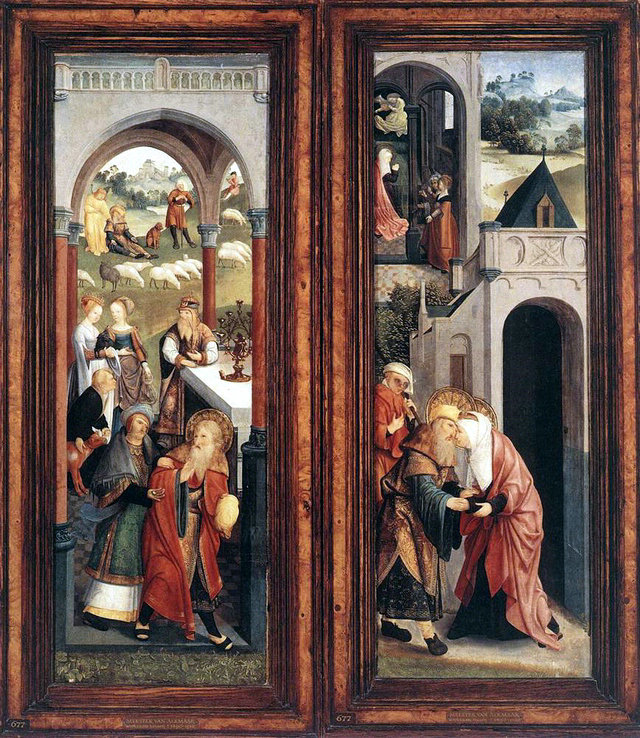Master of Alkmaar


The Master of Alkmaar was a Dutch painter active around Alkmaar at the beginning of the sixteenth century. His name is derived from a series of panel paintings from the church of Saint Lawrence in that city, dated to 1504 and showing the Seven Works of Mercy; they are currently in the Rijksmuseum in Amsterdam.
The work was commissioned by the brotherhood of the Holy Spirit in 1504 for the Grote or Sint-Laurenskerk in Alkmaar. It is assumed that the painter was Cornelis Buys I (suggestion by Max Jakob Friedländer, then strong assumption by Godfridus Johannes Hoogewerff ), a brother of Jacob Cornelisz. van Oostsanen, but also Pieter Gerritsz (as an alternative to Hoogewerffs, according to others too strong an assumption) would be eligible. However, no certainty can be provided for either. The somewhat damaged work belongs to the collection of the Rijksmuseum in Amsterdam, but is currently on loan to Museum Boijmans Van Beuningen in Rotterdam.
The paintings, bearing the stamp of Geertgen tot Sint Jans, are done in bright colors, and their figures are drawn in an exaggeratedly caricatured manner. It has been proposed that this artist is identical to Cornelis Buys I, the brother of Jacob Cornelisz van Oostsanen; he is known to have been active in Alkmaar between 1490 and 1524. More recently, the name of Pieter Gerritsz, originally of Haarlem, has been proposed, he being in Alkmaar beginning in 1502. This artist, in 1518, was compensated for a painting of Saint Bavo in Haarlem, and his name can be found in records of the Egmond Abbey and of the church of Saint Lawrence in Alkmaar, over a period covering the years 1515 to 1529.
The Seven Works of Mercy
His name comes from the series of seven panels commissioned by the Brotherhood of the Holy Spirit of the city and which he painted for the altarpiece of the Great St. Lawrence Church of Alkmaar. They are dated 1504 and are signed with a monogram. Representing the Seven Works of Mercy, they are known as the Altarpiece of the Seven charity.
Each of the panels represents a work of mercy, all of which are enumerated in the Gospel according to Matthew (v. 25: 35-36), with in order from left to right:
1st panel: feed the hungry, Share mildly the poor // god will mercy you again
2nd panel: give drink to the thirsty, You will be given again of food and drink in this life // dark tent error
3rd Panel: clothe the needy, Your people also want to decorate their necktheyt // that God blames your soden
4th panel: bury the dead with dignity, From the dead to be buried so we learn // God’s thobias are being preached. This work is not original of the Gospel: it is additional work added by the Church to the xiii th century
5th panel: welcome foreign, That gentleman speaks Will understand me // what Ghij does to the least was done to me.
6th panel: heal the sick, Want to see and crancken vysent // your wage will be increased
7th panel: visiting prisoners, The prisoner redeemed with caritates // it comes here to benefit his souls.
This altarpiece is now kept at the Rijksmuseum Amsterdam. The paintings, which show a clear influence of Geertgen tot Sint Jans for their architectural style, are made with light colors and their figures are caricatured.
Identity
The style used for the realization of these seven panels is reminiscent of that of Cornelis Buys I, painter of Alkmaar died in 1524 and master of Jan van Scorel, brother of Jacob Cornelisz van Oostsanen and uncle of Dirck Jacobsz, which makes attributing the identity of the Master of Alkmaar to this artist, active between 1490 and 1524.
Later, the name of Pieter Gerritsz, originally from Haarlem, was proposed, having been in Alkmaar from 1502. This artist is known to have a painting of St. Bavo of Ghent in 1518 in Haarlem, and his name is mentioned on the registers of Egmond Abbey and the Great St. Lawrence Church of Alkmaar, for a period covering the years 1515 to 1529.
In addition, his style of representation of the characters and spacious staging is similar to that of Jan Mostaert, which would suggest that the Master of Alkmaar was trained in his studio around 1475.
According to the Bénézit, he worked in Alkmaar between 1490 and 1510, and mentions the name of Pieter Gerritsz (a painter who died in 1540). This research, in his art, to coincide with the picturesque sobriety and seriousness with humor measured.
Conservation
Seven Works of Mercy, Rijksmuseum, Amsterdam;
Adoration of the Magi (triptych), Mauritshuis, The Hague;
The Virgin with St. Anne, Liverpool.
Source from Wikipedia